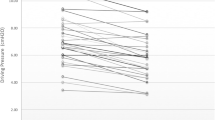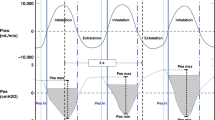Abstract
In kyphoscoliosis (KS), lung volumes are reduced, respiratory elastance and resistance are increased, and breathing pattern is rapid and shallow, attributes that may contribute to defense of tidal volume (VT) in the face of inspiratory resistive loading. The control of ventilation of 12 anesthetized patients about to undergo corrective spinal surgery was compared to that of 11 anesthetized patients free of cardiothoracic disease during quiet breathing and the first breath through one of three linear resistors. Mean forced vital capacity (FVC) of the KS group was 48% that of the controls (C). Passive elastance (Ers) and active elastance and resistance (E′rs and R′rs, respectively) were computed according to previously described techniques (Behrakis PK, Higgs BD, Baydur A, Zin WA, Milic-Emili J (1983) Active inspiratory impedance in halothane-anesthetized humans. J Appl Physiol 54:1477–1481). Baseline tidal volume VT, inspiratory duration TI, expiratory duration TE, duration of total breathing cycle TT, and inspiratory duty cycle TI/TT were significantly reduced, while VE was slightly decreased in the KS. Ers, E′rs, and R′rs, were, respectively, 72, 69, and 89% greater in the KS. Driving pressure (Pmus) was derived from the equation of motion, using active values of respiratory elastance. With resistive loading, there was greater prolongation of TI in the C, while percent reduction in VT and minute ventilation VE was less in KS. Compensation in both groups was achieved through three changes in the Pmus waveform. (1) Peak amplitude increased. (2) The duration of the rising phase increased. (3) The rising Pmus curve became more concave to the time axis. These changes were most marked with application of the highest resistance in both groups. Peak driving pressure and mean rate of rise of Pmus were greater in the KS. Increased intrinsic impedance, Pmus, and differences in changes in neural timing in anesthetized kyphoscoliotics contribute to modestly greater VT defense, compared to that of anesthetized subjects free of cardiorespiratory disease.
Similar content being viewed by others
References
Altose MD, Selsen SG, Cherniack NS (1975) Respiratory responses to changes in airflow resistance in conscious man. Respir Physiol 36:249–260
Axen K, Bergofsky EH (1977) Thoracic reflexes stabilizing loaded ventilation in normal and cordinjured man. J Appl Physiol 43:339–346
Axen K, Bishop M, Haas F (1987) Respiratory load-compensating mechanisms in muscular dystrophy. J Appl Physiol 62:1647–1654
Axen K, Sperber Haas S (1979) Range of first breath ventilatory responses to added mechanical loads in naive man. J Appl Physiol 46:743–751
Banta JV, Park SM (1983) Improvement in pulmonary function in patients having combined anterior and posterior spinal fusion for meningomyelocele scoliosis. Spine 8:765–770
Baydur A (1992) Decay of inspiratory muscle pressure during expiration in anesthetized kyphoscoliosis patients. J Appl Physiol 72:712–720
Baydur A, Swank SM, Stiles CM, Sassoon CSH (1989) Respiratory elastic load compensation in anesthetized patients with kyphoscoliosis. J Appl Physiol 67:1024–1031
Baydur A, Swank SM, Stiles CM, Sassoon CSH (1990) Respiratory mechanics in anesthetized young patients with kyphoscoliosis. Immediate and delayed effects of corrective spinal surgery. Chest 97:1157–1164
Behrakis PK, Higgs BD, Baydur A, Zin WA, Milic-Emili J (1983) Active inspiratory impedance in halothane-anesthetized humans. J Appl Physiol 54:1477–1481
Behrakis PK, Higgs BD, Bevan DR, Milic-Emili J (1985) Partitioning of respiratory mechanics in halothane-anesthetized humans. J Appl Physiol 58:285–289
Campbell EJM, Dinnick OP, Howell JBL (1961) The immediate effects of elastic loads on the breathing of man. J Physiol Lond 156:223–231
Cibella F, Cuttitta G, Romano S, Grassino A, Bellia V (1994) Ventilatory response to spontaneous resistive load variations during sleep. J Appl Physiol 76:2394–2404
Cobb JR (1948) Outline for the study of scoliosis. Am Acad Orthop Surg Lect 5:261–275
Eldridge FL, Vaughn ZN (1977) Relationship of thoracic volume and airway occlusion pressure: muscular effects. J Appl Physiol 43:312–321
Evanich MJ, Lopata M, Lourenco RV (1976) Phrenic nerve activity and occlusion pressure changes during CO2 rebreathing in cats. 41:536–543
Grimby G, Takishima T, Graham W, Macklem P, Mead J (1968) Frequency dependence of flow resistance in patients with obstructive lung disease. J Clin Invest 47:1455–1465
Hays WL (1981) Statistics 3rd ed. Holt, Rinehart, & Winston, New York
Im Hof V, West P, Younes M (1986) Steady-state response of normal subjects to inspiratory resistive load. J Appl Physiol 60:1471–1481
Kryger MH, Yacoub O, Anthonisen NR (1975) Effect of inspiratory resistance on occlusion pressure in hypoxia and hypercapnia. Respir Physiol 24:241–248
Lin HL, Nash CL, Herndon CH, Anderson NB (1974) The effect of corrective surgery on pulmonary function in scoliosis. J Bone Joint Surg Am 56:1173–1179
Lindh M, Bjure J (1975) Lung volumes in scoliosis before and after correction by the Harrington instrumentation method. Acta Orthop Scand 46:934–948
Lopata M, Evanich J, Lourenco RV (1977) Relationship between mouth occlusion pressure and electrical activity of the diaphragm: effects of flow resistive loading. Am Rev Respir Dis 116:449–455
Lourenco RV, Cherniack NS, Malm JR, Fishman AP (1966) Nervous output from the respiratory center during obstructed breathing. J Appl Physiol 21:527–533
Margaria C, Iscoe S, Pengelly LD, Couture J, Don H, Milic-Emili J (1973) Immediate ventilatory response to elastic loads and positive pressure in man. Respir Physiol 18:347–369
Mead J (1968) Mechanical factors in the control of breathing—three problems. Howell JBL, Campbell EJM (eds) In: Breathlessness. Oxford, Blackwell, pp 139–146
Moe JH, Winter RB, Bradford DS, Lonstein JE (1978) Scoliosis and Other Spinal Deformities. WB Saunders, Philadelphia, p 10
Morris JF, Koski A, Johnson LC (1971) Spirometric standards for healthy nonsmoking adults. Am Rev Respir Dis 103:57–61
Pengelly LD, Alderson AM, Milic-Emili J (1971) Mechanics of the diaphragm. J Appl Physiol 30:797–805
Pengelly LD, Greener J, Bowmer I, Luterman A, Milic-Emili J (1975) Effect of added elastances on the first loaded breath in man. J Physiol 38:39–43
Read DJC, Freedman S, Kafer ER (1974) Pressures developed by loaded inspiratory muscles in conscious and anesthetized man. J Appl Physiol 37:207–218
Sakic K, Pecina M, Fadila P (1992) Cardiorespiratory function in surgically treated thoracic scoliosis with respect to degree and apex of scoliotic curve. Respiration 59:327–331
Sampson MJ, DeTroyer A (1982) Role of intercostal muscles in the rib cage distortions produced by inspiratory loads. J Appl Physiol 52:517–523
Shee CD, Ploy-Song-Sang Y, Milic-Emili J (1985) Decay of inspiratory muscle pressure during expiration in conscious humans. J Appl Physiol 58:1859–1865
Whitelaw WA, Derenne J-P, Couture J, Milie-Emili J (1976) Adaptation of anesthetized man to breathing through an inspiratory resistor. J Appl Physiol 41:285–291
Younes M, Riddle W (1981) A model for the relation between respiratory neural and mechanical outputs. I. Theory. J Appl Physiol 51:963–978
Younes M, Riddle W, Polacheck J (1981) A model for the relation between respiratory neural and mechanical outputs. III. Experimental Validation. J Appl Physiol 51:910–1001
Zin WA, Behrakis PK, Luijendijk SCM, Higgs BD, Baydur A, Böddener A, Milic-Emili J (1986) Immediate response to resistive loading in anesthetized humans. J Appl Physiol 60:506–512
Zin WA, Pengelly LD, Milic-Emili J (1982) Active impedance of respiratory system in anesthetized cats. J Appl Physiol 53:149–157
Author information
Authors and Affiliations
Additional information
Offprint requests to: Ahmet Baydur
Rights and permissions
About this article
Cite this article
Baydur, A., Carlson, M. Immediate response to inspiratory resistive loading in anesthetized patients with kyphoscoliosis: Spirometric and neural effects. Lung 174, 99–118 (1996). https://doi.org/10.1007/BF00177704
Accepted:
Issue Date:
DOI: https://doi.org/10.1007/BF00177704




